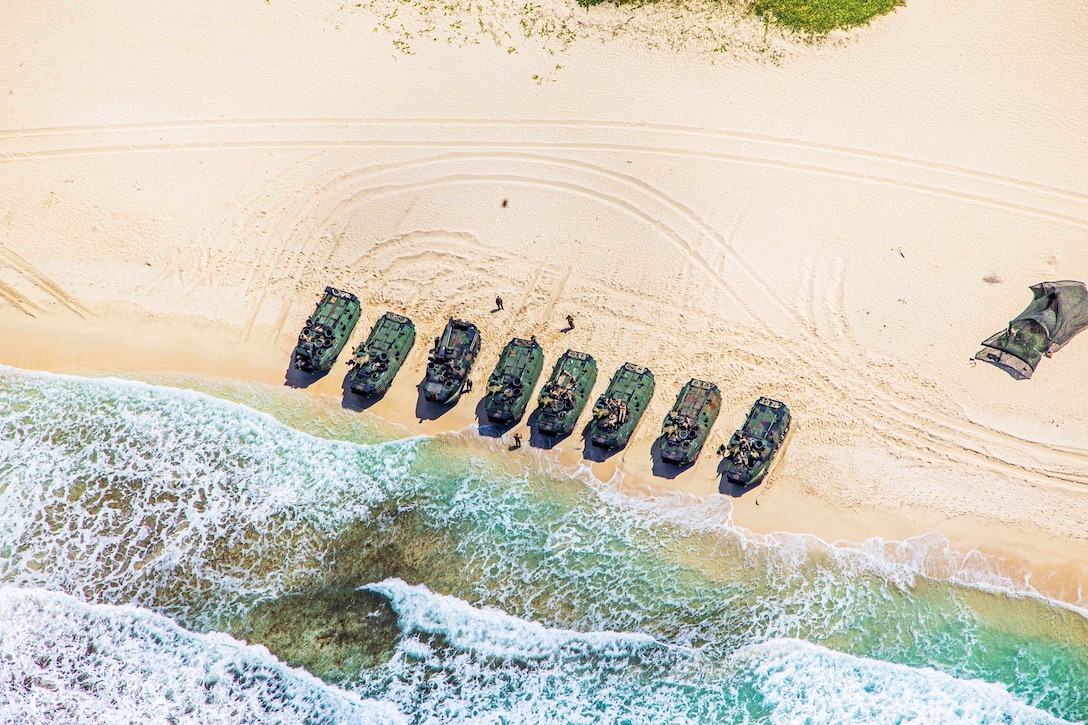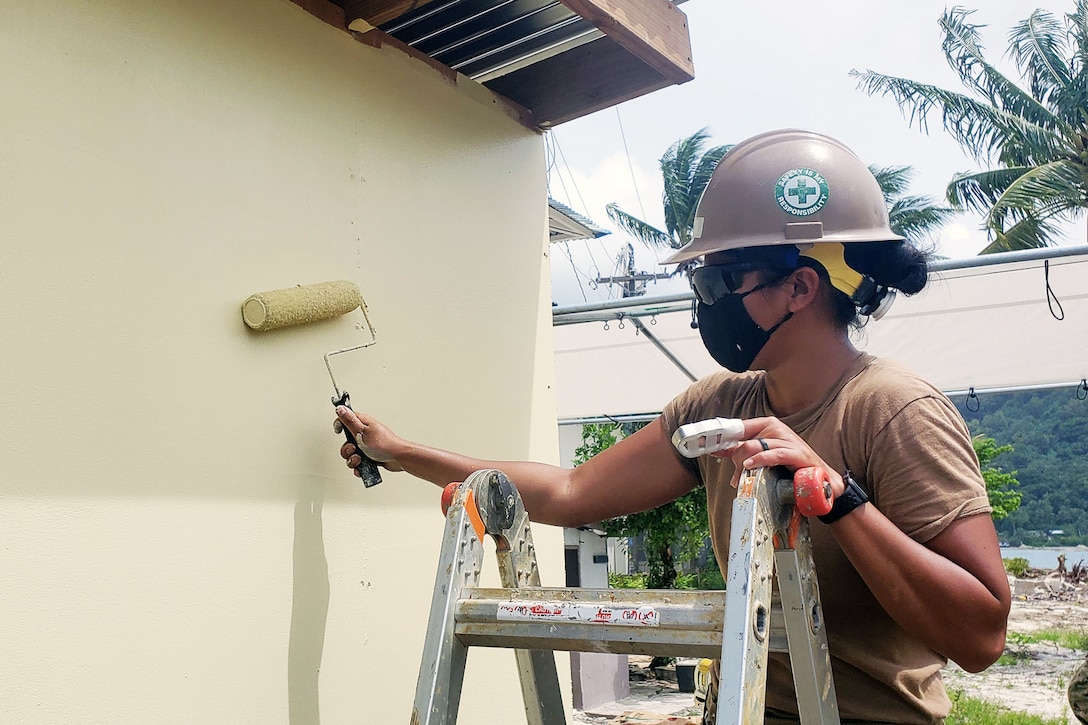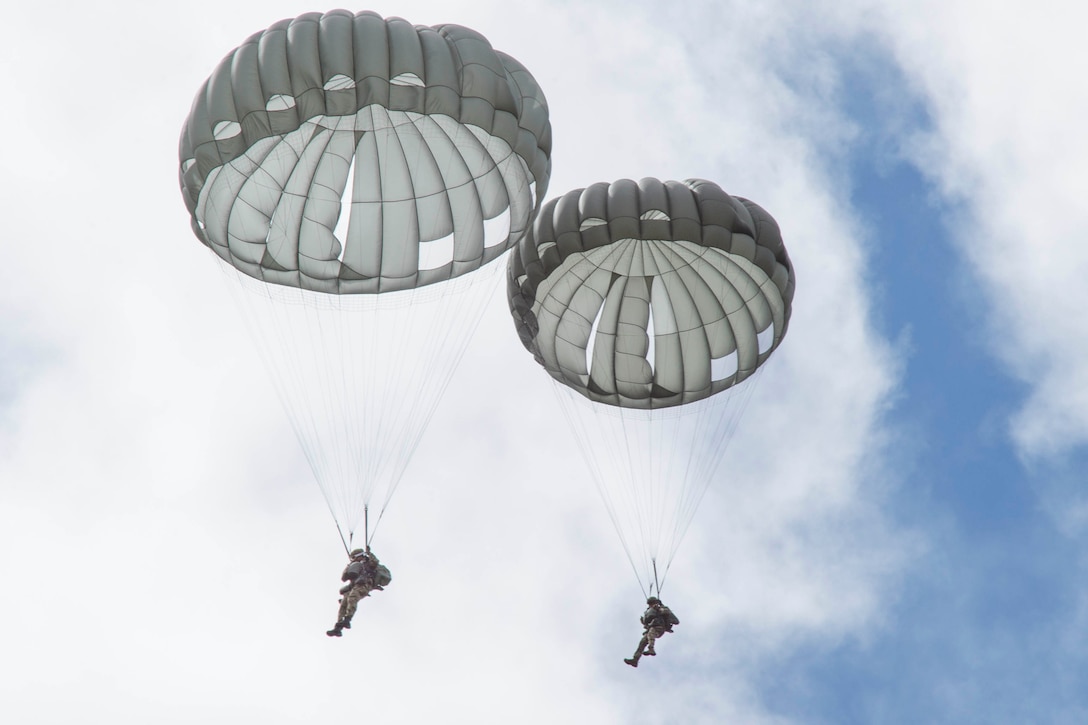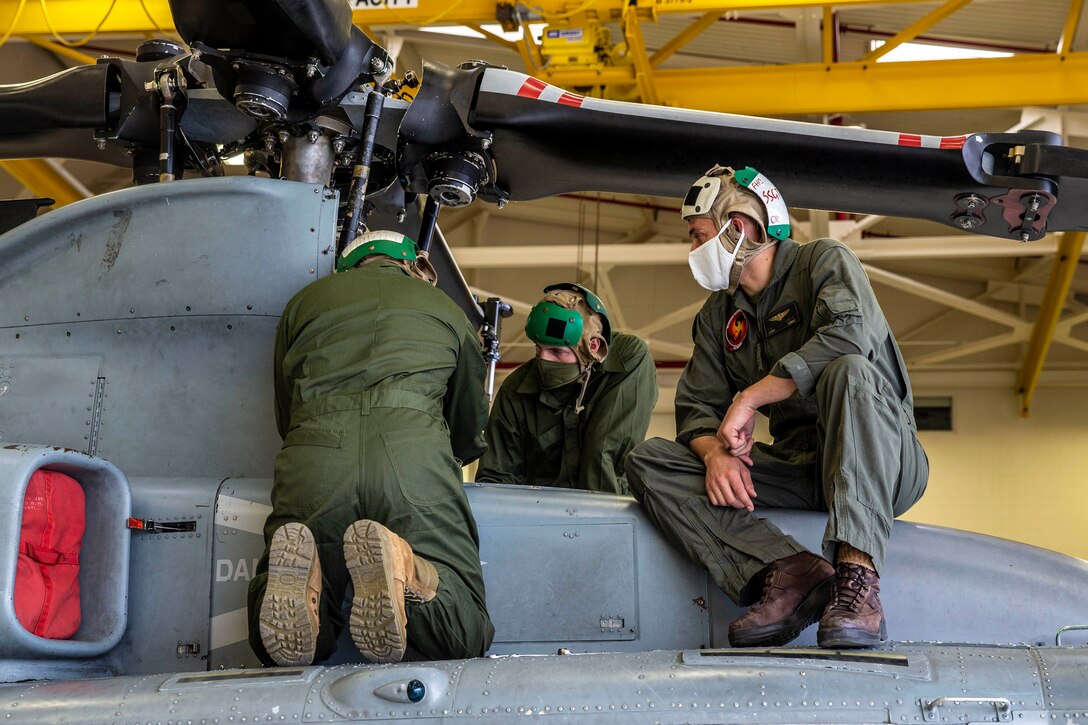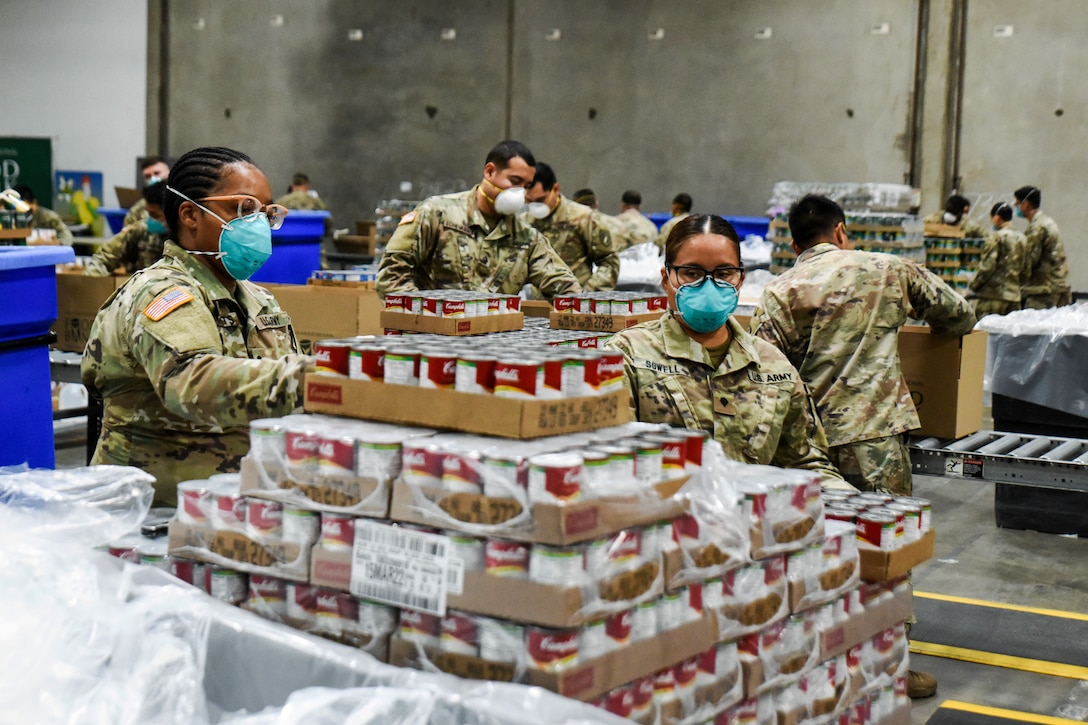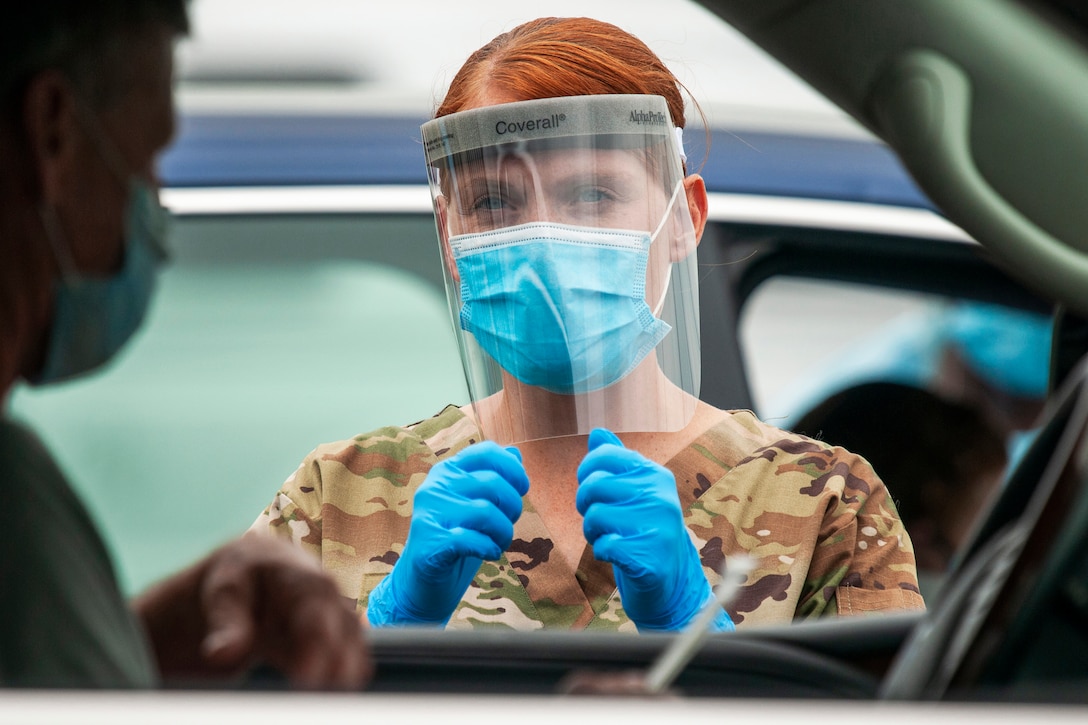Marines stage assault amphibious vehicles during around-the-clock operations at Marine Corps Base Hawaii, May 28, 2020.
Tuesday, June 02, 2020
Face of Defense: Sibling-Soldiers
For Army Maj. Nicholas Fiore, Maj. Elyse Pierre and Capt. Carolyn "Nina" Fiore, family ties bolster their shared commitment to duty and service.
Raised in a military family, all three siblings graduated from the U.S. Military Academy at West Point, New York, before embarking on their Army careers. They recently talked about their upbringing and what military service means to them.
Nicholas: armor officer and future operations planner
Elyse: medical officer and board-certified doctor
Nina: aviation officer and commander, Troop D, 3rd Squadron, 6th Cavalry Regiment, 1st Armored Division Combat Aviation Brigade
Growing Up Military
Military children are more likely than their peers to join the military. About 80 percent of recent recruits come from a family where at least one close relative was in uniform.
The Fiore siblings' father, Uldric "Ric" Fiore, served in the Army for 30 years and is a retired member of the Senior Executive Service as a judge advocate general director for the Army. Their mother, Nancy Colfax, graduated from Vermont Law School and worked as a lawyer for a time.
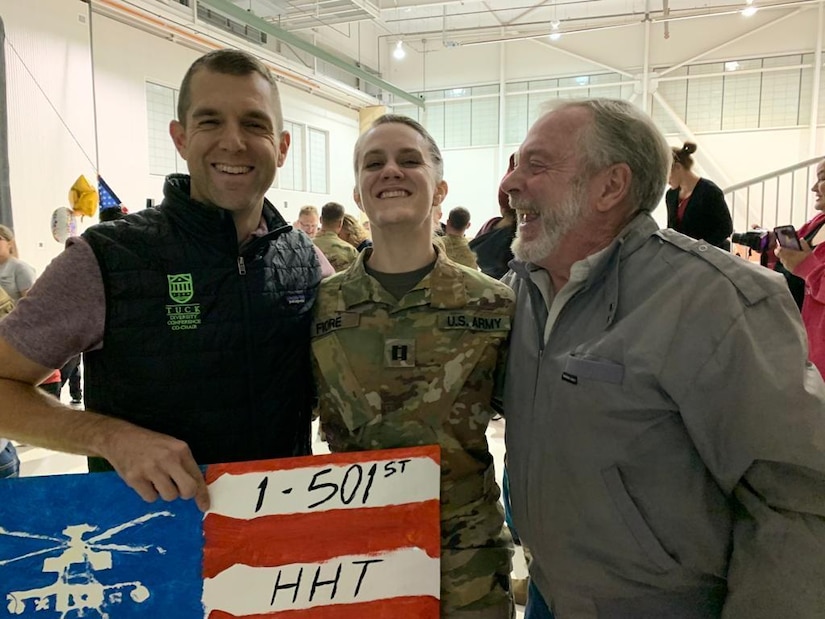
Throughout their childhoods, the Fiore siblings saw the sacrifice and dedication of their parents as they adjusted to the challenges that face military families.
"One of the things that I think drives a lot of young families out of the Army is that they realize that they just can't manage two careers," Nicholas said. "Our mother chose to stay at home, even though I know that she missed practicing law and that she was good at it."
Rising to Challenges
Even when she transitioned out of her career, their mother didn't stop working, he said, describing her tireless efforts to help military families.
"She would take me with her, with the little red plastic lunchbox and the Lion King VHS, when she would volunteer on post and still use her skills to help out soldier families wherever we were."
The family adapted to the challenges of military life, and made sure those challenges did not interfere with childhood excitement and opportunity.
"We moved around a lot and that tends to cause Army children to have one of two reactions, 'I don't ever want to move again' or 'Hey, it's kind of cool to travel around the world and see different places'" Ric said. "I think our children enjoyed the traveling piece, so they were not adversely influenced by all the moving and we always made sure that their schools were a priority."
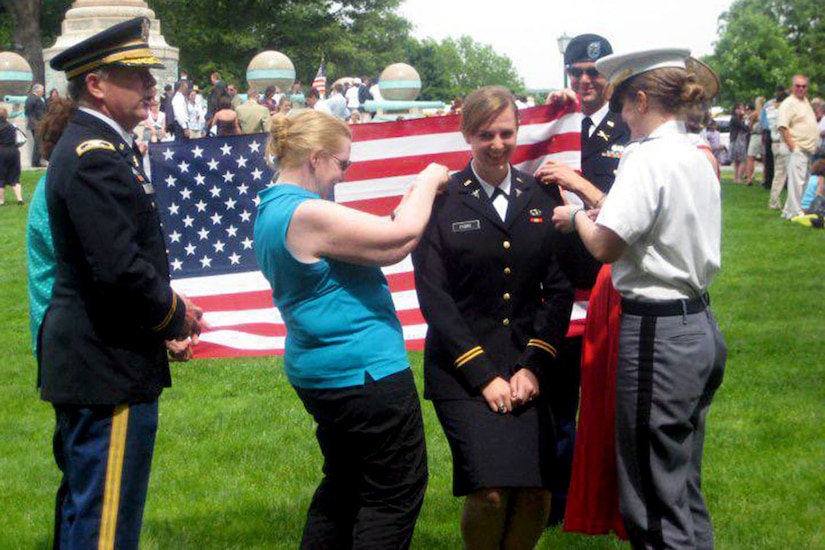
West Point Pride
Despite the frequent moves, the Fiore family established a strong identification with West Point.
"When my parents were growing up, West Point was the biggest college nearby, so they went to West Point football games even though they didn't have a family connection to the Army," Nicholas said. "I remember going to those tailgates as a kid and that definitely attracted me."
Each of the three siblings retained a sense of independence and individuality but ultimately, each chose West Point as the place to pursue their goals. Nicholas graduated 2007, Elyse in 2010 and Nina in 2013.
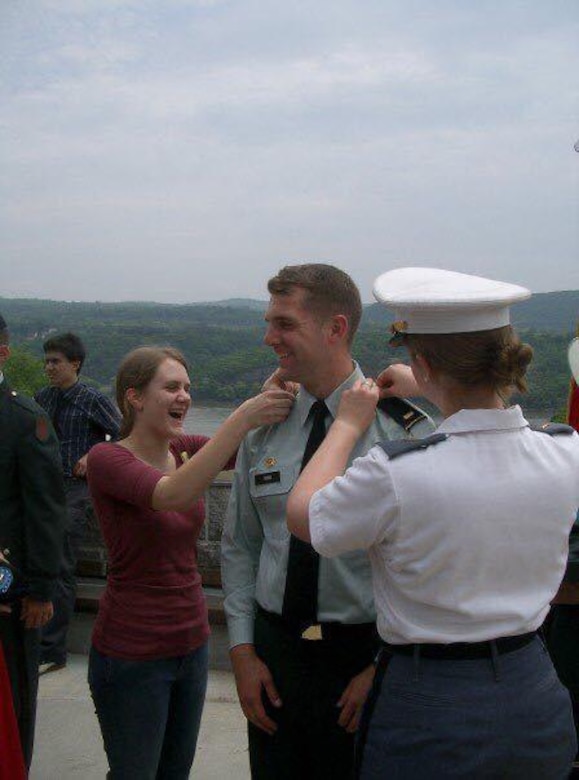
"When Nic was applying to colleges, he was looking at St. John's University and Johns Hopkins University but eventually decided that he wanted to go to West Point," Nina said. "Our sister Elyse decided that going to West Point to be a physician for the Army was what she wanted, to help keep soldiers healthy and not just go work in a practice somewhere tucked away in a corner of a big office building."
"I've wanted to fly helicopters since about the time they convinced me I couldn't be a bird when I grew up," she continued, "so for me that was a no-brainer."
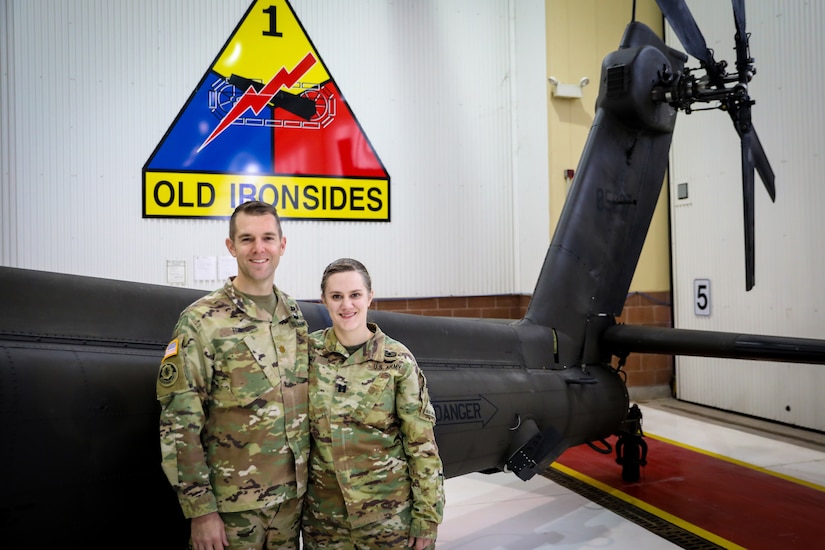
Family Within a Family
Serving as an armor officer, an aviation officer and a medical officer results in very different experiences for the siblings, but they remain close knit and supportive of one another nevertheless — a family within the Army family.
"All of us are committed to serving other soldiers and Americans as best we can, Nina said. "We're fortunate to have the ability and the opportunity to do so."
Adapted from an article by Army Pfc. Matthew Marcellus
Statement by Assistant to the Secretary of Defense for Public Affairs on Support to Civil Authorities
Attributable to Jonathan Rath Hoffman, Assistant to the Secretary of Defense for Public Affairs:
The Department of Defense moved multiple active duty Army units into the National Capitol Region as a prudent planning measure in response to ongoing support to civil authorities operations.
The Secretary of Defense authorized the movement of an infantry battalion designated Task Force 504, assigned to the Army’s Immediate Response Force based at Fort Bragg, North Carolina.
Additionally, at the Department’s direction, the U.S. Northern Command commander authorized the move of the 16th Military Police Brigade headquarters from Fort Bragg, North Carolina, and the 91st Military Police Battalion from Fort Drum, New York. The brigade provides a command and control element for the battalion, which primarily provides military police and engineering capability.
Active duty elements moved to the National Capitol Region by military aircraft over the last 24 hours.
Active duty elements are postured on military bases in the National Capitol Region but are not in Washington DC. They are on heightened alert status but remain under Title X authority and are not participating in defense support to civil authority operations.
The overall number of active duty troops recently moved from Fort Bragg and Fort Drum is approximately 1600 troops.
Air Force Secretary Gets Update on Kirtland's Mission During COVID-19

The secretary visited the base May 20-21.
"Team Kirtland's myriad of missions don't stop because of COVID-19." Barrett said. "Today's visit was an opportunity to personally thank and observe how service members and civilians have adapted and continue to modernize the Air and Space Forces."
Barrett began the visit at the Air Force Research Laboratory's Directed Energy and Space Vehicles Directorates, where she was briefed on several programs critical to the nation’s defense.
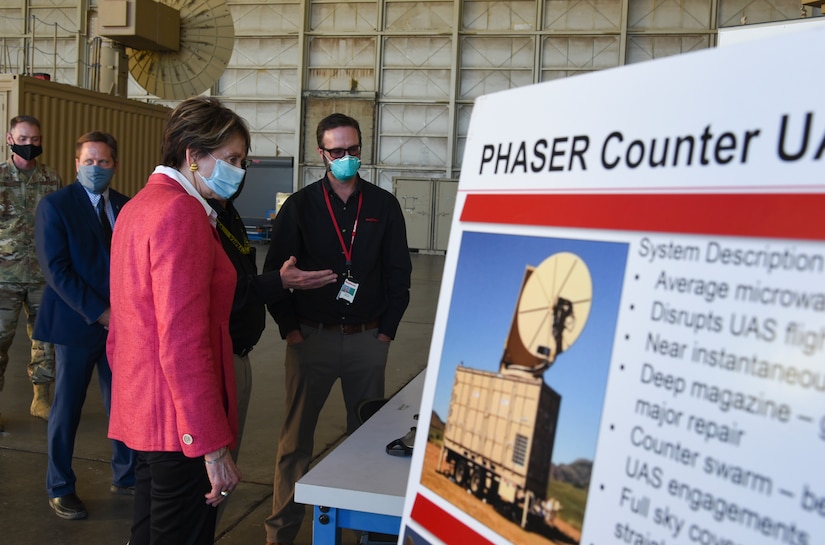
Dr. Kelly Hammett, the director , introduced Barrett to a variety of high-power microwave and high-energy laser systems in development. Hammett showcased the Raytheon PHASER and AFRL THOR high-power microwave systems for countering small unmanned aerial systems, as well as the CHIMERA high-power microwave system being tested for additional base defense capabilities.
"Combatant commanders are very interested in these transportable systems that can nonkinetically defeat multiple air base threats, while providing a deep magazine and low cost per shot," Hammett said.
Barrett received briefings on the space vehicle's small-satellite portfolio and detailed presentations on the directorate’s spacecraft now in orbit.
"The Air Force Research Lab has an amazing pipeline of space science and technology innovations focused on increasing the resiliency of our nation's space capabilities so that we deter conflict in space," said Air Force Col. Eric Felt, the lab's director.
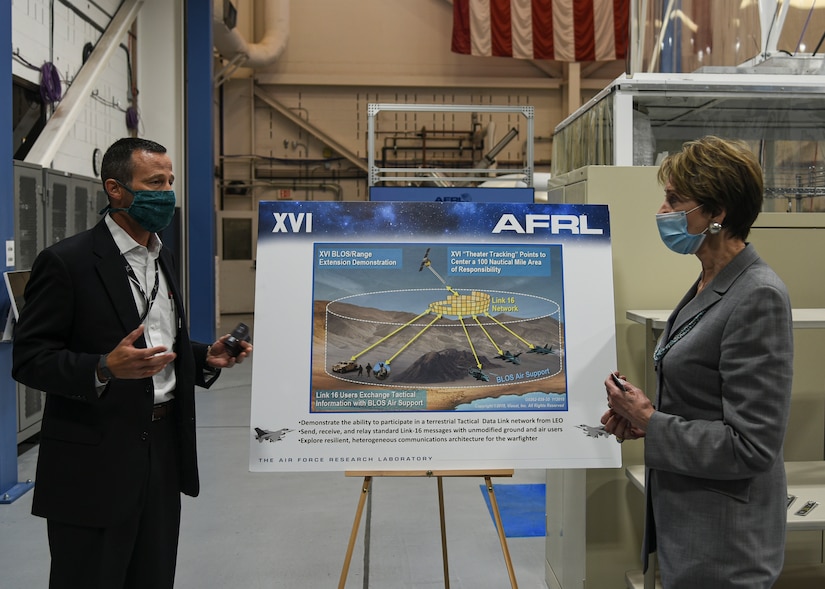
The base visit continued to the Air Force Nuclear Weapons Center, where Barrett was brought up to date on critical programs and how they line up with her priorities as the Air Force secretary. The planned transfer of AFRL missions to the Space Force continues, despite the COVID-19 pandemic.
Barrett was briefed on the center's plans for returning to full mission capability during the COVID-19 pandemic, said Air Force Maj. Gen. Shaun Morris, the commander of AFNWC and the Air Force program executive officer for strategic systems. "Given the absolutely critical nature of our role in providing nuclear capabilities to the warfighter, we are committed to maintaining full support despite COVID-19. To date, we've kept all key efforts on track and in line with her nuclear deterrence priorities."

Barrett also visited the Space Rapid Capabilities Office to familiarize herself with its mission and transition to the Space Force.
"As one of the key acquisition organizations of the U.S. Space Force, the Space RCO is laser focused on meeting our mission to develop and deliver critical space capabilities at the speed of relevance," said Mike Roberts, the RCO director. "The Space RCO is honored to have the opportunity for our workforce to meet [Barrett], given the secretary's leadership has been key in empowering our ability to meet our mission."
Barrett visited the Space and Missile Systems Center Innovation and Prototyping Directorate to better understand how the center accelerates the pivot to the new space architecture.
"We were particularly excited to showcase the partnerships we share with other space organizations here at Kirtland Air Force Base and across the [Defense Department]," said Air Force Col. Timothy Sejba, the director of SMC innovation and prototyping.
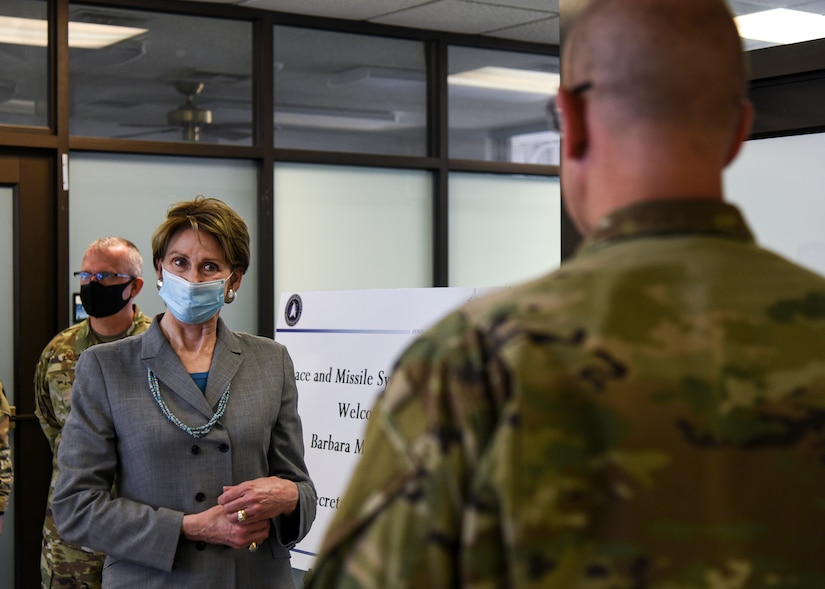
Throughout the visit, Barrett emphasized the importance of the multiple national security mission sets on Kirtland and not only how critical their capabilities are, but also how vital the workforce is for mission readiness and success. Social distancing, face coverings and "elbow" greetings were routine during the visit.
"It was an amazing opportunity for our airmen to spend time with Secretary Barrett," said Air Force Col. David S. Miller, the commander of the 377th Air Base Wing. "Her trip to Kirtland certainly underscores the importance of the work by all of the men and women on Team Kirtland, and the installation's contributions to national security."
Javits Farewell
Army Col. Kimberlee Aiello, right, commander of the 44th Medical Brigade, gives an elbow bump to Air Force Maj. Carrie Gaddy, assigned to the 64th Air Expeditionary Group, during an award and farewell ceremony at the Javits Center in New York City, May 28, 2020. Military medical providers assigned to the hospital collaborated as an integrated system to support the New York City medical system as part of the Defense Department’s COVID-19 response efforts.
Pohnpei Paint
Navy Seaman Shareine May, assigned to the Naval Mobile Construction Battalion 5 Detail Pohnpei, paints a mobile bathroom and shower facility designed by Navy Seabees to help prepare a COVID-19 response compound for the Pohnpei State Medical Task Force at Misco Beach in Pohnpei, Micronesia, May 20, 2020. NMCB-5 is deployed across the Indo-Pacific region conducting high-quality construction to support U.S. and partner nations to strengthen partnerships, deter aggression and enable expeditionary logistics and naval power projection.
Dual Descent
Airmen descend during airborne training at Joint Base Elmendorf-Richardson, Alaska, May 26, 2020. The training helps maintain operational readiness during the pandemic.
Department of Defense Announces Tour Length Change for the Middle East
The Department of Defense has changed the current overseas tour length for DoD military personnel under COCOM (Title 10) authority assigned to permanent duty locations in the Arabian Peninsula and Iraq.
As a byproduct of the Department's continuous reassessment of personnel policies worldwide, DoD military personnel will gradually transition to 12-month unaccompanied tours for designated duty stations in the region.
This change will not affect the number or readiness of U.S. forces in the region.
DoD military personnel currently assigned to the region will finish out their accompanied tours and cycle out gradually over the course of two years. Those who have orders to prepare to move up to 30 days from today will be allowed to PCS to their accompanied tour, though all accompanied tours must be complete by August 31, 2022.
While this change applies to a number of countries in the region, only Bahrain and Qatar currently host military families under COCOM authority.
The Department remains committed to supporting our partners in this vital region.
The policy can be found here and a corresponding fact sheet can be found here.
Marine Education
Marine Corps students with the Center for Naval Aviation Technical Training Camp Pendleton conduct maintenance on a UH-1Y Venom helicopter at Marine Corps Base Camp Pendleton, Calif., May 28, 2020. Students and staff took strict precautionary measures to combat the spread of COVID-19.
Department of Defense Accepts Korean Ministry of Defense's Proposal to Fund Korean National Employee Labor Costs
The Department of Defense has accepted the Republic of Korea’s (ROK) proposal to fund the labor costs for all U.S. Forces Korea (USFK) Korean National (KN) employees through the end of 2020.
The lapse of last year's 10th Special Measures Agreement (SMA), in which the Republic of Korea partially shared the burden of stationing U.S. Forces on the peninsula, and the continued absence of a subsequent agreement, resulted in more than 4,000 Korean National employees being furloughed.
USFK expects all KN employees to return to work no later than mid-June.
In March, prior to the partial furlough, the DoD funded critical logistics contracts and partially funded KN labor to mitigate some of the risk associated with a complete furlough. This enabled USFK to accomplish their mission to maintain a robust combined defense posture.
Since the last SMA lapsed on 31 December 2019, the United States has unilaterally shouldered the burden for all costs associated with U.S. Forces in Korea. These include KN labor costs, logistics contracts, and construction project design and oversight costs. Today’s decision will provide over $200M in ROK funding for USFK’s entire KN workforce through the end of 2020. Additionally, it is a direct reflection of the United States’ commitment to readiness, to our Korean employees, and to the Alliance - “the linchpin of peace and stability on the Korean peninsula.”
This decision enables a more equitable sharing of the KN employee labor burden by the ROK and the U.S. More importantly, it sustains the Alliance’s number one priority - our combined defense posture.
In regards to the lapsed SMA, the Department of Defense believes that equitable burden-sharing between the governments of the United States and the Republic of Korea is in the best interest of all parties. We strongly encourage our Ally to reach a fair agreement as quickly as possible. The United States has shown considerable flexibility in their approach to the SMA negotiations, and requests that the ROK does the same.
Without an agreed upon SMA, critical defense infrastructure projects will remain suspended, all logistics support contracts for USFK will continue to be paid completely by the U.S., and burden sharing will remain out of balance for an Alliance that values and desires parity. USFK’s mid- and long-term force readiness remains at risk.
Food Kits
Soldiers assigned to the California Army National Guard’s 224th Sustainment Brigade assemble emergency food kits during a COVID-19 humanitarian response mission at the Los Angeles Regional Food Bank in Commerce, Calif., May 29, 2020. With Cal Guard’s assistance, the food bank is building more than 10,000 kits a day and recently surpassed a milestone of 300,000 kits built since troops arrived in mid-April.
Drive-Thru Test
Delaware Army National Guard Pfc. Kelly Buterbaugh gives instructions to a motorist during a drive-thru coronavirus testing mission at the University of Delaware's Science, Technology and Advanced Research Campus in Newark, Del., May 29, 2020. About 25 soldiers and airmen with the Delaware National Guard supported the saliva-based testing of roughly 400 people at the STAR Campus location.
Oklahoma National Guard Supports Statewide COVID-19 Contact Tracing
In this latest push, Oklahoma guardsmen are helping with contact tracing, which is the process of tracing and monitoring the contacts of infected people.

"We're minimizing the spread and helping with the community," said Army Sgt. Anna Aranda, a member of the Oklahoma National Guard who serves as the noncommissioned officer in charge of the guardsmen working at the Texas County Health Department in Guymon, Oklahoma. "We're working closely with the Oklahoma State Department of Health and making a tremendous impact with them. You know, they needed our help, and so we're here."
The tracing, which begins with a positive COVID-19 test, follows the same procedures for any other disease or contagion tracing process. An employee from the Health Department makes the initial call, and after confirming their identity, informs the individual of the positive test result. They then work with the call recipient to voluntarily build a list of contacts who could have had exposure to the infected individual. That list gets passed to a trained person who then follows up with each of the contacts.
"There's the same procedure, same protocol, same stratagems to limit exposure," said Eddie Garza, a disease intervention specialist with the Oklahoma State Health Department. "But morbidity is so high here — and actually everywhere in Oklahoma, but especially in Texas County — that we needed reinforcements. The National Guard has been a tremendous help in contact tracing, because for one person who tests positive, we've had upwards of 10 to 15, sometimes 25 contacts."
Guardsmen working in a call center setup are trained to make the calls to each of the contacts while also protecting the contact's identity and medical information. Despite the "tracing" aspect of the interactions, the initial outreach begins regular contact with potentially infected people for the duration of their contagious period. These phone calls can include education of symptoms and prevention, resources such as food and supplies for those who need to quarantine and symptom monitoring for those who contract COVID-19 or have the potential to.

"We make phone calls and we inform them of their possible contact, and the response has been great," Aranda said. "Most everyone has been polite, encouraging and thanking us for following up with them. A lot of them are worried, you know, of course, and you've got to show empathy. You build a kind of trust with them."
For Aranda's region, which focuses heavily on Guymon, being bilingual provides a special skill set that goes further than their contact tracing training and is especially important. The population of Guymon speaks 37 different languages, with English and Spanish being the most prominent.
"We want to help the community to feel safe and for them to have an understanding of what we’re saying," Aranda said. "We have three service members who are bilingual, and they are a tremendous asset to our team. You want to speak the language that you're comfortable with, so that's what we do, and that gives them peace of mind when we call them."
Aranda, who is one of the three bilingual guardsmen there, says their ability to communicate with the community has really built rapport with those they have contacted.
"They're not afraid," she said. "They're not scared. So it makes me feel great that we're making such a big impact in this community. It's an amazing feeling. You can't beat that."
Aranda said the trust between the community and the guardsmen who are helping to carry out the contact tracing in their area is paramount to the success of their jobs as contact tracers.
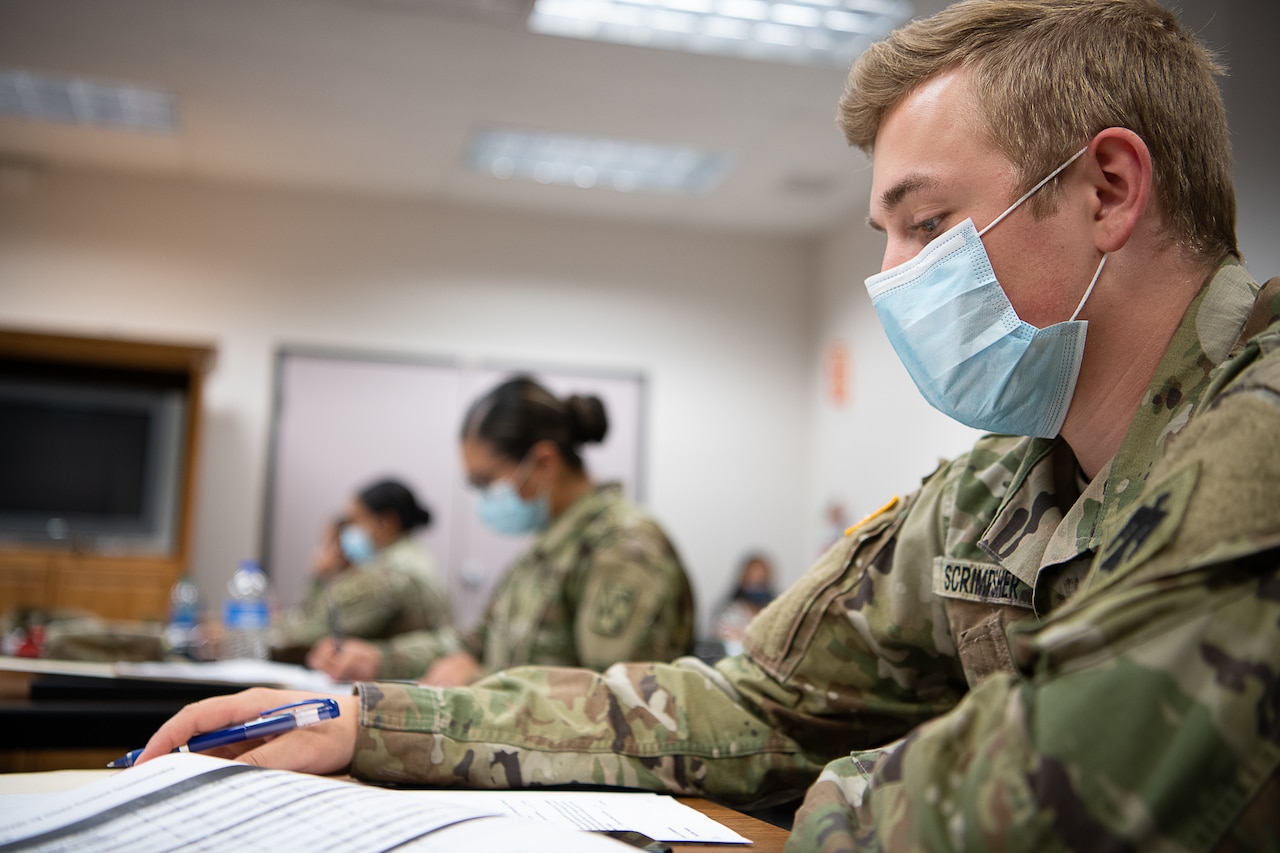
"When we do contact tracing, there is fear that people have in the community about privacy," Aranda explained. "So we're not there to worry about what they're doing. We're just worried about their symptoms and making sure that they are aware that they came in contact with somebody with COVID-19. So our goal is to make them aware so they can help [prevent] the spread, and they’re usually grateful for that."
An exponential increase in the number of COVID-19 cases in Guymon demanded more contract tracing. Since their arrival in May, the guardsmen from the Oklahoma Air and Army National Guard have more than doubled the calling and testing capacity in the area.
"The guard has probably doubled my staff here in Guymon," said Terri Salisbury, the Oklahoma State Health Department regional director. "I really appreciate the National Guard coming out and being so willing [to help]. Most people don't come to Guymon, Oklahoma, and they've all been great. They've stayed and worked through the weekends and everything else. So I'm very, very thankful for them."
Teams like this one are spread throughout the state to help their communities limit their exposure to COVID-19 and fight against the pandemic together alongside other state agencies.
(Air Force Tech. Sgt. Kasey Phipps is assigned to the Oklahoma Air National Guard.)
Baseball 'Legend' Abner Doubleday Also Served in the Union Army
Most sporting events have been postponed or cancelled due to the COVID-19 pandemic. Because many service members are sports fans and the games are mostly on hold, here's a look at a purported baseball legend who also served in the Army.
For a very long time, Abner Doubleday was widely thought to have invented the game in 1839 at age 20 in his hometown of Cooperstown, New York.
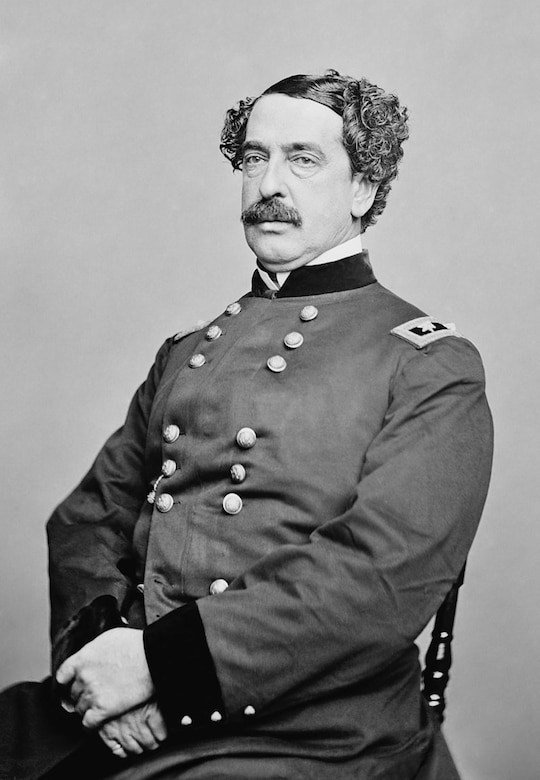
However, that year, Doubleday was a cadet at the U.S. Military Academy in West Point, New York, and permission to travel home was rarely granted to first-year cadets. Doubleday never claimed to have invented the sport; nonetheless, the claims were made by others after his death.
Although variations of baseball were thought to have existed as early as the Revolutionary War, no one knows exactly who created the game.
In 1907, the Mills Commission, composed of seven prominent baseball officials and former players, investigated the matter and deemed Doubleday was baseball's inventor. But sports historians later said the commission's findings were flawed due to lack of solid evidence.
Still, the findings were great news for the local businesses in Cooperstown and major league officials, who established the town's National Baseball Hall of Fame and Museum in 1939, which today is a major tourist attraction.
Another myth is that Doubleday invented San Francisco's cable cars. He did co-establish the city's first cable car company, however.
Aside from baseball and the cable car, Doubleday's life and illustrious military career were fascinating.
After graduating from West Point in 1842, he became an artillery officer with the 3rd Artillery Regiment. He and the regiment were deployed to Mexico from 1846 to 1848 during the Mexican-American War.
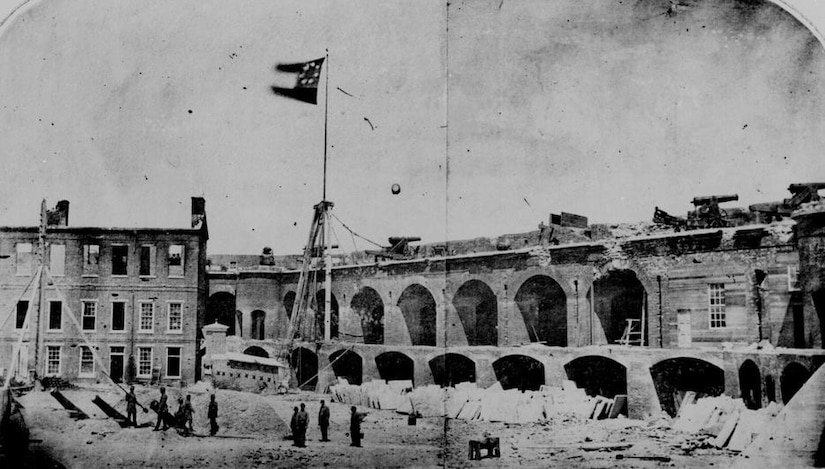
He later was assigned to Florida from 1855 to 1858 where he participated in the Third Seminole War.
The following year found Doubleday at Fort Moultrie on Sullivan's Island, South Carolina. Secessionist fervor was sweeping large areas of the South, and many officers resigned their commissions to join the rebellion.
In the face of growing hostility to Union soldiers, the garrison commander decided to move the garrison to nearby Fort Sumter, which was considered more defensible.
After a four-month standoff, the South Carolina militia attacked the fort with artillery. Doubleday is said to have aimed his battery to fire the first return shot. As a result, he and his gun crew were the Union soldiers who fired the first shot that started the Civil War on April 12, 1861.
With supplies and munitions low, after 34 hours of bombardment, the Union soldiers — led by Army Maj. Robert Anderson and second-in-command Doubleday — surrendered.
The garrison was allowed to depart and head north, since it was so early in the war and prisoners were not yet being taken. After a promotion to major, Doubleday commanded artillery defenses around Washington, D.C.
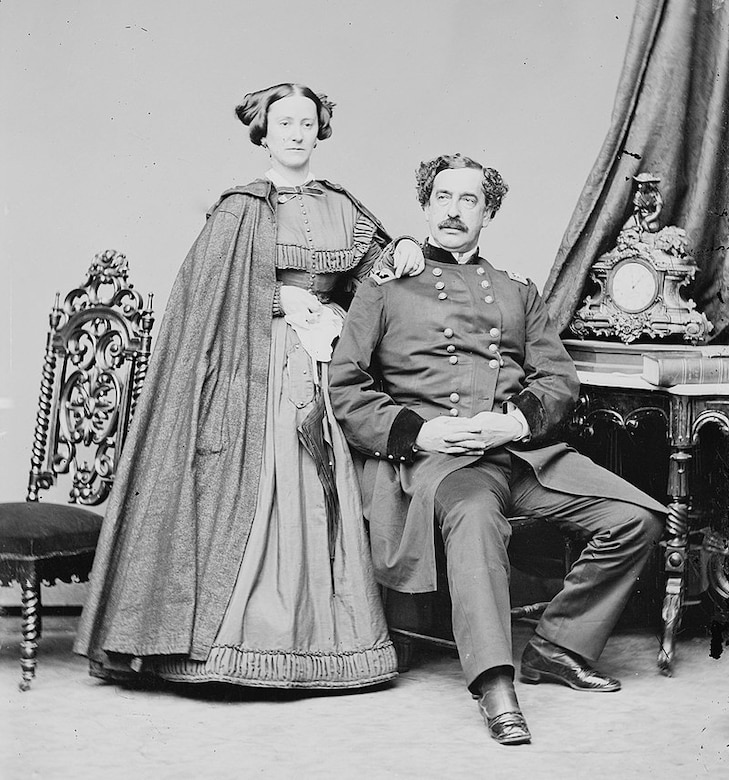
Following a rapid promotion to brigadier general, he was given command of a brigade, under Army Gen. Irvin McDowell. On Aug. 29-30, 1862, he led his men into combat at the Second Battle of Bull Run, which Southerners even today call the Battle of Second Manassas.
During the ensuing battle, his men helped hold the line against Confederate Maj. Gen. Thomas ''Stonewall'' Jackson's advance for a time. However, on Aug. 30, Confederate Maj. Gen. James Longstreet pushed back all the Union soldiers, including McDowell's.
Nonetheless, Doubleday is said to have conducted himself well during the battle.
Doubleday participated in many more battles, including the Battle of South Mountain, Sept. 14, 1862, near Boonsboro, Maryland. During the battle, Army Brig. Gen. John P. Hatch was wounded so Doubleday took command of I Corps and successfully blocked a Confederate assault.
At the Battle of Antietam on Sept. 17, 1862, near Sharpsburg, Maryland, Doubleday led a division assigned to I Corps. About 23,000 men on both sides were killed. He, again, did well leading men on the battlefield during the bloodiest day of battle in U.S. history. He was promoted to major general about two months later.
After leading his division again in combat during the Battle of Fredericksburg in Virginia on Dec. 11-15, 1862, Doubleday was assigned to command a new division.
From April 30 to May 6, 1863, Doubleday led this division at the Battle of Chancellorsville in Spotsylvania County, Virginia.
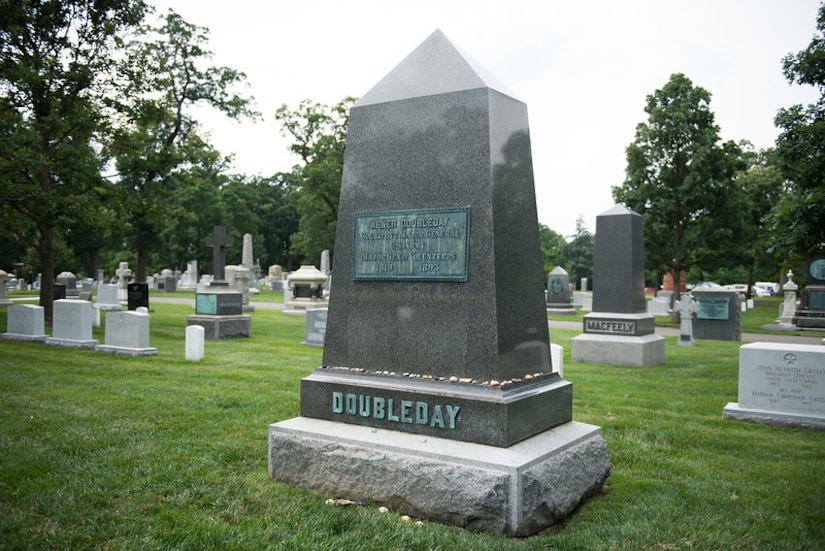
Perhaps Doubleday's biggest moment of glory, however, was at the Battle of Gettysburg in Pennsylvania on July 1-3, 1863.
On the first day of battle, I Corps commander, Army Maj. Gen. John F. Reynolds was killed, and Doubleday took his place. His 9,500 men held back more than 16,000 Confederate attackers.
Despite his unit's extraordinary heroism, Doubleday was relieved of command on day two of the battle by Army of the Potomac commander Maj. Gen. George G. Meade. It has been said that Meade personally disliked Doubleday. After having been relieved of command from I Corps, Doubleday again became a division commander for the remaining days of the battle.
Doubleday had a number of other assignments during the Civil War, and, unlike many of his fellow officers, he remained in the Army when the war ended.
In 1871, he commanded the 24th U.S. Infantry Regiment, an all African-American regiment headquartered at Fort McKavett, Texas. Doubleday requisitioned baseballs and baseball bats for his regiment, valuing sports as a camaraderie-building activity. It is said that he did this throughout his Army career.
Two years later Doubleday retired from the Army.
Other Interesting Facts
- The baseball field at the U.S. Military Academy at West Point was named Doubleday Field in his honor in 1939, the same year the National Baseball Hall of Fame and Museum opened. Many baseball fields around the U.S. are also named Doubleday Field, including in Cooperstown, which opened in 1920.
- Doubleday’s father, Ulysses Doubleday, fought in the War of 1812 and was a U.S. congressman, representing the 24th District in New York. Doubleday’s grandfather fought in the Revolutionary War at Bunker Hill, Stoney Point and at Valley Forge.
- Abraham Gilbert Mills, who headed the Mills Commission which was to determine the origin of baseball, also has an interesting background. He enlisted in the 5th New York Volunteers in 1862 as a private. During the war, he was commissioned a second lieutenant and served for the duration of the war.
- During World War II, the liberty ship SS Abner Doubleday was named in his honor.
- Doubleday, who died in 1898 at age 73, is buried at Arlington National Cemetery in Section 1, Grave 61, very close to the James Tanner Amphitheater.
